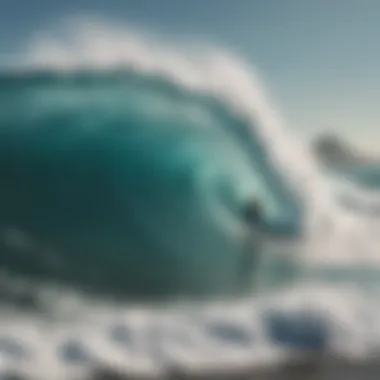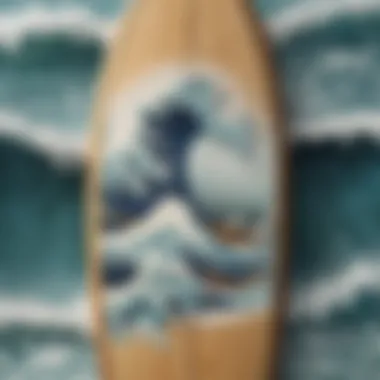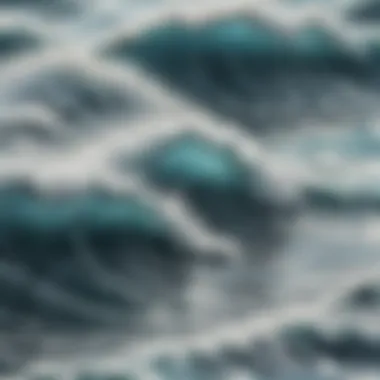Exploring the Depths of Japanese Wave Print Art


Intro
Japanese wave print, with its rhythmic lines and fluid forms, is not just a visual feast but a rich storytelling device. This art form has roots that go deep into history, echoing the relationship between humanity and the sea. From the grand Great Wave off Kanagawa by Hokusai to the modern renditions seen on surfboards today, this motif carries cultural weight and significance. As surfers ride the waves, they may not realize that beneath their feet lies a vibrant piece of art steeped in tradition and ethos.
The Roots of Japanese Wave Print
The story of Japanese wave print begins centuries ago, intertwining with the nation’s maritime culture. During the Edo period, artists like Hokusai began to capture the essence of the sea. Waves were not merely decorative; they represented nature's power and unpredictability, reflecting the tumultuous feelings of life itself. Their detailed depiction showcased skill but also a philosophical viewpoint of embracing change and adversity.
Japanese wave prints often symbolize a deeper connection to the ocean, much like how a surfer should respect the water’s whims. By embracing this intricate art form, practitioners of the surf culture align with a tradition that venerates the waves.
Artistic Significance
Japanese wave prints are made with precision, underscoring a meticulous blend of technique and narrative. The lines and shapes are not random; they mirror nature’s dance—an eternal cycle of creation and destruction. The colors also play a crucial role. Shades of blue often seen in these prints invoke tranquility while hinting at the ocean's depths.
They serve as a reminder for surfers today: every wave tells a story. By embracing the aesthetics of wave prints, one acknowledges the beauty and peril of the ocean. In this way, Japanese art and surf culture have a mutualistic relationship where each learns from the other, enriching the experience for both artists and surfers.
The Intersection of Tradition and Modernity
Fast-forward to the present, and we notice that contemporary surf culture hasn’t swallowed the old ways; instead, it has folded them in. Modern surfboards often display these valued prints, striking a balance between craft and lifestyle. As surfboard designs evolve toward performance, artistic elements like Japanese wave prints remain essential. They not only serve as inspiration but also as a bridge, connecting surfers to a cultural heritage that endows their sport with meaning.
"Art is a way of organizing the world within us, and surf culture is a vital expression of that arrangement."
Cultural Narratives and Philosophies
Wave prints convey a philosophical tone. The act of surfing itself embodies the idea of yin and yang; balance is paramount between rider and wave. It grounds one in the present moment, much like the focus required in observing art. Thus, those who appreciate Japanese wave print may also find a new layer of understanding in their surfing practice.
This synthesis of art and action starts new conversations about the ecological awareness responsible for preserving oceans. The intertwining stories of wave art and surf culture invite surfers to ponder their impact on the very waves they ride.
Finale
Ultimately, delving into Japanese wave prints reveals a tapestry of shared experience, evolution, and respect for nature. As surf culture continues to embrace its aesthetic roots, both surfers and artists alike should remain mindful of the narratives that each wave carries. Recognizing the importance of historical context brings one closer to not just riding waves, but to understanding their significance within a broader cultural landscape.
Understanding Japanese Wave Print
Japanese wave print, often hailed for its intricate designs and cultural significance, is not merely a visual element but a captivating narrative steeped in history and philosophy. Understanding this art form helps us appreciate its multifaceted nature, highlighting how it transcends time and continues to inspire various domains, particularly in surf culture.
Historically, wave prints echo the dynamic relationship between humans and nature. They are a reminder of the ocean's power, beauty, and mystery, reflecting the deep respect that Japanese culture has for its maritime environment. Such designs often evoke feelings of both tranquility and determination, making them particularly resonant for surfers who embrace the sea's unpredictability.
By examining the origins, symbolism, and key artists behind wave motifs, we can unravel the rich narrative that this art form embodies. This understanding invites us to explore the details that may often go overlooked—like the use of colors, proportions, and patterns—and how these elements come together to form a cohesive aesthetic statement.
Origins and Historical Context
The roots of Japanese wave print can be traced back to the Edo period (1603–1868), when printmaking flourished as an artistic medium. Artists such as Katsushika Hokusai and Utagawa Hiroshige popularized the wave as a central motif in their works. These artists didn’t just depict waves; they expressed a connection to nature that resonated deeply with their contemporaries.
The iconic "Great Wave off Kanagawa" by Hokusai, for instance, is more than a painting; it's a cultural artifact that embodies the tumultuous relationship between humanity and nature. Set against the backdrop of Mount Fuji, the wave stands as a formidable force, illustrating the sheer power of the ocean while reinforcing a sense of humility in the face of natural elements.
Symbolism of Waves in Japanese Art


In Japanese art, waves symbolize various concepts, from strength and resilience to the passage of time. Waves are often portrayed as both beautiful and threatening, reflecting life's dualities—just like the ebbs and flows we experience as individuals.
The wave motif reminds viewers of the interconnectedness of life; it embodies change, movement, and the inevitability of transformation. In many pieces, waves are shown crashing against rocks, representing challenges faced in life—where one must remain steadfast yet fluid in response. Thus, the symbolism of waves can be deeply personal, inviting reflection on one’s own journey.
Key Artists Influenced by Wave Motifs
Several artists have left a lasting mark on the concept of wave prints, shaping how we perceive this motif today. Hokusai takes center stage, not solely due to his famous wave artwork but also because of his innovative techniques that made printed images more accessible to the general public. His work epitomizes the ethos of Japanese wave print and continues to be a source of inspiration beyond the confines of art galleries.
Another notable figure is Hiroshige, whose attention to detail and masterful handling of color have transformed the perception of waves in art. Each brushstroke from these artists is akin to a wave in the ocean—fluid, dynamic, and forever influencing the artistic tide.
The interplay of traditional techniques and modern interpretations in Japanese wave print unveils a landscape rich in creativity and cultural significance.
This examination of wave prints not only provides insights into the aesthetic appeal and historical context but serves as a bridge to understanding their continued relevance in today’s world. By grasping the essence of Japanese wave art, one can appreciate how it speaks volumes to surfers and art enthusiasts alike.
The Aesthetic Appeal of Wave Prints
Japanese wave print, often characterized by its intricately detailed patterns and serene color palettes, holds a special place in the hearts of art aficionados and surfers alike. The aesthetic charm of these prints transcends mere visual allure; it immerses viewers into a deep appreciation of both nature and culture. The elements of color, texture, and design in wave prints create a striking visual experience, making them not just art pieces, but also a celebration of tranquility and movement. This section delves into the various elements that constitute the aesthetic appeal of wave prints, examining why they resonate so profoundly with individuals across different fields, especially in the realms of surfing and design.
Color Schemes and Patterns
The color schemes found in Japanese wave prints are typically rich and varied. Artists often use deep indigos, soft blues, and contrasting whites to illustrate waves that seem almost alive on the canvas. These colors reflect the natural marine environment and evoke feelings of calmness and serenity. The patterns used in wave prints are intricate, with flowing lines that mimic the rhythm of ocean waves. Here, some common aspects include:
- Contrast of Colors: The juxtaposition of darker and lighter hues can create a sense of depth, allowing each wave to appear as if it’s rolling forward.
- Repetition and Rhythm: Repeated patterns convey motion, capturing the perpetual flow of water and its interaction with light.
- Geometric Influence: Some prints incorporate geometric designs, blending traditional art with modern aesthetics. This can provide a unique twist that appeals to contemporary audiences.
The overall impact of these color schemes and patterns is profound—they not only beautify spaces but also communicate deeper cultural narratives, inviting viewers to reflect on their connections to nature.
Textures and Material Considerations
When it comes to textures and materials, the touch and feel of wave prints play a vital role. The physical properties of the materials used often define how the art resonates with its audience. Here are a few notable considerations:
- Print Mediums: Traditional woodblock printing on rice paper creates a delicate texture that enhances the visual effect. The softness of the paper can add an intimate quality to the art.
- Fabric Choices: In fashion, fabrics like silk or cotton carry wave prints beautifully. The way these materials drape or crease can transform the print, offering different angles and aspects of appreciation.
- Layering Techniques: Glossy finishes or layering can add depth and richness, making prints seem three-dimensional. This depth draws people in, encouraging them to examine the artwork closely.
In essence, the physical aspects of materials and textures can transform visual experiences into tactile ones, which enhance the overall aesthetic appeal of wave prints.
Applications in Fashion and Graphic Design
The adaptability of wave prints has led them to find a diverse array of applications, particularly in fashion and graphic design. In these fields, the wave motif is not just a print; it’s a statement. Here’s how its integration manifests:
- Fashion Statements: From swimwear to high fashion, wave prints are utilized to evoke feelings of beach life, freedom, and adventure. Designers often blend traditional motifs with modern styles, creating pieces that are both timeless and trendy.
- Graphic Design Sensibilities: In branding, wave patterns serve as an embodiment of dynamism and creativity. They provide a perfect backdrop for logos or promotional materials, giving a fresh and natural touch.
- Home Décor: Their application extends to textiles in home décor—curtains, cushions, and rugs adorned with wave prints can brighten up spaces and emulate a seaside ambiance.
The versatility of Japanese wave prints continues to inspire innovation in both fashion and design, making them a timeless motif cherished around the globe.
Japanese Wave Print in Surf Culture
Japanese wave print has made waves, quite literally, in the realm of surf culture. This unique art form, recognizable by its flowing patterns and vibrant color schemes, has transcended mere aesthetics to become an integral part of the surfing lifestyle and identity. Surfers not only appreciate wave print for its artistic value but also resonate with its deeper meanings and historical underpinnings. In this section, we will unfold various layers that contribute to the significance of Japanese wave print within surf culture.
Translating Art into Surfboards
When you take a good look at a surfboard, it's more than just a piece of foam and fiberglass; it embodies the spirit of the ocean and the artistry that often goes unseen. The infusion of Japanese wave prints into surfboard designs has transformed them into canvases of cultural storytelling.


Many surfboard manufacturers, like Lost Surfboards, are incorporating this traditional art form into their designs, creating a fusion of history and sport. For example, a surfboard adorned with the iconic Great Wave off Kanagawa not only showcases beauty but also connects the surfer to the rich traditions of Japanese art. Such designs invite onlookers to appreciate a narrative that intertwines art, culture, and sport; a compelling reason for surfers to choose these unique boards.
This practice serves multiple functions. It not only elevates the visual appeal but also imparts a sense of connection with nature and history, establishing a deeper bond between the surfer and the ocean.
The Role of Wave Print in Surfboard Brands
Surfer culture thrives on identity, and for many, their surfboards speak volumes. Brands have started recognizing the alluring charm of Japanese wave print as a way to differentiate themselves. By adopting this motif, brands like Channel Islands and Walden Surfboards evoke a sense of artistry and tradition which resonates with their target audience.
Using wave prints is not just a marketing gimmick; it reflects a broader ethos. Surfers are increasingly drawn to brands that respect and honor the cultural roots of art, aligning with their values and appreciation for nature.
Moreover, this technique highlights the craftsmanship involved in creating each board. Customers often appreciate the attention to detail in incorporating such intricate designs, drawing parallels between surf culture and the meticulousness of Japanese art forms.
Influence on Surfboard Customization Trends
Customization in surfboards has been gaining traction, with surfers wanting to express themselves through their gear. Integrating Japanese wave prints into this personalization trend has emerged as a popular choice. Surfers are not merely adding a flashy design; they are often seeking visuals that resonate with deeper meanings, reflecting their values, beliefs, or experiences.
For instance:
- Using wave prints to signify resilience in the face of challenges.
- The flowing patterns might symbolize a surfer’s journey through life.
As a result, we see companies like Shaper Studios and Epoxy Surf paving the way for surfboard customization that allows individuals to select wave print art that personally speaks to them. These facets do not just spotlight individuality; they frame surfing as an expression of identity, stretching beyond the act of riding a wave to encapsulate one's life story.
"In the ocean, every wave is unique, much like every surfer's journey."
This narrative has become a bedrock principle for folks looking to not just surf but also to convey their own tales through their gear. Ultimately, it elevates the notion of surfing from mere sport to a multidimensional lifestyle.
As we delve deeper into how Japanese wave print plays a role in surf culture, it becomes apparent that this art form enriches, informs, and enhances the relationship surfers have with their sport, their boards, and the ocean itself.
Cultural Implications of Japanese Wave Print
Japanese wave print is more than just an artistic expression; it’s a vital conduit through which cultural narratives flow. This motif reflects a rich tapestry of tradition while carving out new spaces in modern interpretations. By examining these cultural implications, we can appreciate how wave prints serve as a bridge between history and present-day dialogues, infusing depth into both artistic practice and lifestyle.
Fusion of Tradition and Modernity
At first glance, the elegance of traditional Japanese wave prints, such as those seen in Hokusai's "The Great Wave off Kanagawa," might suggest a strict adherence to historical aesthetics. However, reality complexly intertwines these ancient influences with modern design ideologies. Artists today often incorporate wave motifs into various contemporary forms, from streetwear to home decor.
The sustenance of traditions amidst evolving styles showcases a vibrant part of Japanese culture. Artists blend bold colors and innovative techniques without losing sight of the signature swirling lines that represent waves. They create a dialogue between the old and the new—by merging hand-drawn prints with digital processes, they honor heritage and embrace the now. It’s a dance of creative synthesis that speaks to both nostalgic collectors and younger, urban audiences, marking a revival of interest in this timeless motif.
Environmental Perspectives in Art
Waves also signify something broader within the art realm—an acknowledgment of nature. Japan’s coastal landscapes, where ocean and culture meet, serve as a constant reminder of the environment's fragility. Artists and designers are increasingly reflecting on sustainable practices in their wave prints, incorporating natural materials and eco-friendly inks into their production processes.
The intention here is not merely aesthetic but moral. By choosing sustainable materials, artists advocate for environmental stewardship. Many find that traditional techniques align with green practices, as methods like block printing often utilize resources that are less detrimental to the environment. Thus, Japanese wave print encapsulates not just beauty, but a deeper awareness of the ecological responsibility artists have as gatekeepers of culture.
Global Reception and Adaptation
As wave motifs travel beyond Japan’s shores, they evolve and adapt in different cultural contexts. The global reception of Japanese wave print has diversified its presence in various art forms, especially in surf culture where many enthusiasts actively celebrate the ocean.
From surfboards painted with traditional wave patterns to the incorporation of wave themes in graphic novels, the motif has found new life in unexpected realms.


- Influence on global fashion: Designers worldwide draw inspiration from these prints, leading to collections that echo Japanese heritage while introducing fresh interpretations.
- Art exhibitions: Galleries around the globe have showcased works inspired by Japanese wave prints, prompting conversations about cultural exchange and appropriation.
"The beauty of Japanese wave print lies in its ability to evolve while preserving its essence, demonstrating how art can transcend borders and time."
Contemporary Interpretations and Innovations
Japanese wave prints have evolved significantly over time, with contemporary interpretations shining a light on their multifaceted nature. This section delves into how modern artists, designers, and brands infuse these traditional motifs into new creative expressions. The significance lies not only in aesthetics but also in the blending of traditional techniques with innovative practices that speak to current audiences.
Digital Adaptations of Wave Prints
In the digital age, the transformative power of technology has led to fresh adaptations of Japanese wave prints. Designers are using software tools to manipulate and reinterpret these waves in ways that were unimaginable in the past.
- For instance, using software like Adobe Illustrator, artists can create dynamic patterns that blend colors and forms, giving a new life to age-old wave motifs.
- Moreover, digital printing techniques allow for intricate designs on diverse materials, which enhances accessibility and application. Products such as yoga mats, wallpapers, and apparel showcase these adaptations, appealing to a broader audience.
- Websites and e-commerce platforms have emerged as vital channels where these adaptations are shared, making them available to surfers, travelers, and outdoor enthusiasts worldwide.
This digital revolution ensures that the wave print not only retains its beauty but also reaches new horizons, contributing to a global appreciation of the art form.
Emerging Artists and New Perspectives
A new wave of artists is taking center stage, infusing their unique interpretations into the world of Japanese wave prints. Their fresh perspectives challenge the traditional narratives while preserving the cultural essence.
- Many of these emerging artists are hybrid creators, combining traditional techniques with contemporary styles that resonate with younger generations.
- For example, street artists in urban environments incorporate wave motifs into mural art, creating unexpected juxtapositions that speak to the hustle and flow of city life, maintaining a connection to nature.
- Additionally, multidisciplinary approaches are becoming popular, where artists collaborate with fashion designers to create limited edition clothing lines featuring wave prints, ensuring that this art form remains relevant in style and culture.
Their boldness in interpretation encourages a dialogue between the past and the present, demonstrating that Japanese wave prints are far from static.
Sustainable Practices in Wave Print Production
Sustainability is a pressing concern in all art and design fields, and Japanese wave print production is no exception. The integration of eco-friendly practices contributes to the longevity of these traditional designs while addressing contemporary environmental challenges.
- Many artists now focus on using natural dyes and organic materials to produce their prints. This approach not only honors the traditional methods but also enhances the art's ethical footprint.
- Recycling old textiles and repurposing them into new creations is another trend gaining momentum. This practice not only aids in waste reduction but also adds unique stories to each piece, making every wave print distinct.
- Furthermore, brands are increasingly transparent about their production processes, allowing consumers to make informed choices that align with their values.
As artists and manufacturers adapt to sustainable practices, they not only safeguard the environment but also ensure that Japanese wave prints continue to thrive in future generations.
In summary, contemporary interpretations and innovations of Japanese wave prints reflect a vibrant synthesis of tradition and modernity, showcasing the adaptability and enduring appeal of this iconic motif.
Culmination
In wrapping up our discussion on Japanese wave print, it becomes clear that this motif is not just an aesthetic choice, but rather a rich tapestry woven from historical, cultural, and artistic threads. This art form stands as a testament to the enduring legacy of Japan's artistic sensibilities, blending the past and the present in a seamless way. Its significance stretches far beyond the realms of surf culture, reaching into various aspects of design, fashion, and even lifestyle.
The Enduring Legacy of Japanese Wave Print
The legacy of Japanese wave print is deeply enshrined in the fabric of both traditional and contemporary art. Historically, it has played a pivotal role in shaping visual narratives within Japanese culture. The iconic patterns, like those found in Katsushika Hokusai's works, speak volumes about the relationship between man and nature.
- Cultural Symbolism: Waves carry various meanings, from strength and resilience, to the impermanence of existence, resonating well with the Japanese concept of mono no aware, or the beauty of impermanence.
- Artistic Influence: Many modern artists and designers draw inspiration from these traditional motifs. Their ability to evoke emotional responses makes them highly relevant today.
- Integration in Daily Life: Whether seen on clothing, surfboards, or home decor, wave prints serve as a reminder of the natural world's dynamic beauty and its delicate balance.
"In each wave lies a story, connecting our past with the modern world."
The legacy is a gentle reminder that appreciating nature, even through the lens of art, can foster a deeper understanding of ourselves and our place in the world.
Future Directions for Art and Surf Culture
Looking ahead, the interplay between traditional wave prints and surf culture is bound to evolve further. As sustainability becomes a key concern globally, the methods of printing and materials used could pivot significantly. Here’s what we might expect:
- Sustainable Practices: Increased focus on eco-friendly inks and materials may reshape manufacturing processes in art and surfboard design.
- Digital Integration: With technology leaning heavily on digital resources, expect to see more innovative designs that blend traditional motifs with modern aesthetics.
- Cultural Exchange: As global awareness grows, there may be a richer dialogue between different cultures, melding various artistic expressions while paying homage to their roots.
One thing remains certain: as waves carve their mark on both the ocean and on canvas, their influence will ripple through future generations, inspiring new artists, surfers, and outdoor enthusiasts alike.



